After 12 hours, Kilauea volcano’s latest eruption pauses
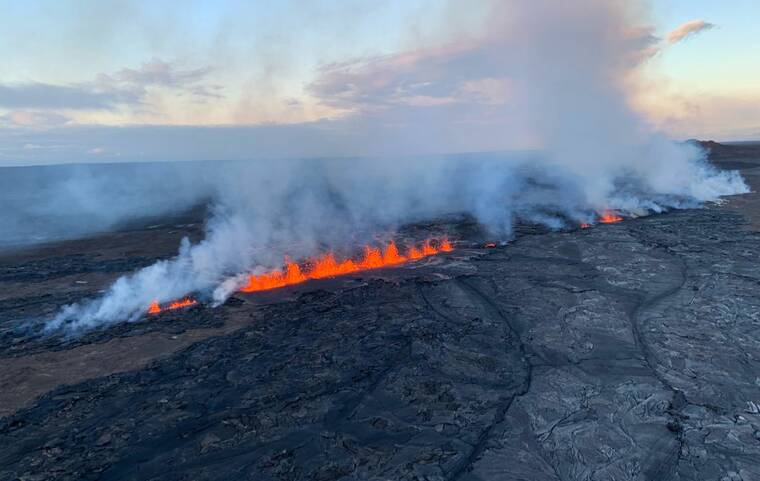
COURTESY USGS
An aerial image of the Southwest Rift Zone eruption of Kīlauea, viewed during an overflight at approximately 6 a.m. today.
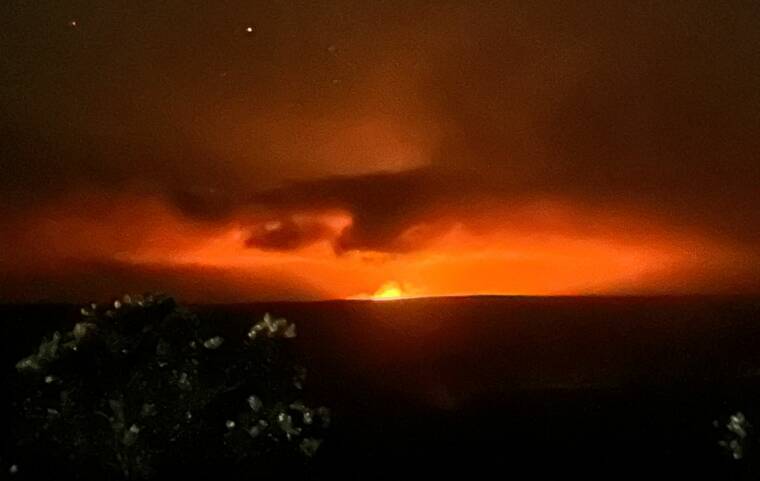
COURTESY VOLCANO HOUSE
Kilauea Volcano began erupting at about 12:30 a.m. today about a mile south of Kilauea caldera. This view shows the glow from the new eruption visible from Volcano House in Hawai’i Volcanoes National Park during the early morning hours today.

COURTESY USGS
Kilauea Volcano began erupting at about 12:30 a.m. today. Hawaiian Volcano Observatory officials said the new eruption is about a mile south of Kilauea caldera and north of the Koa’e fault system and Hilina Pali Road, within Hawaii Volcanoes National Park.
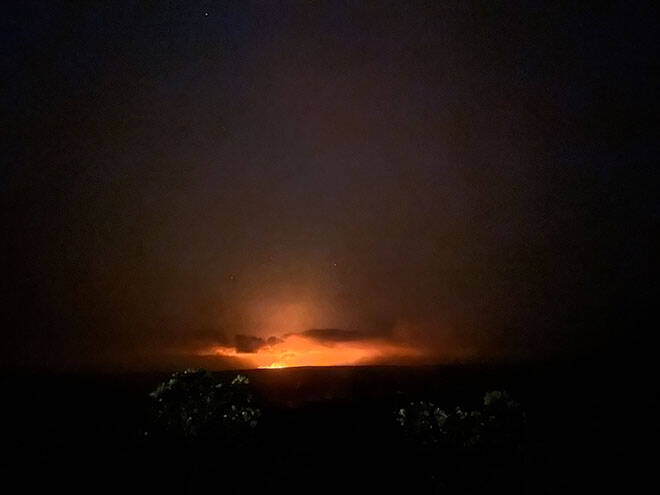
COURTESY USGS
Kilauea Volcano began erupting at about 12:30 a.m. today. Hawaiian Volcano Observatory officials said the new eruption is about a mile south of Kilauea caldera and north of the Koa’e fault system and Hilina Pali Road, within Hawaii Volcanoes National Park.
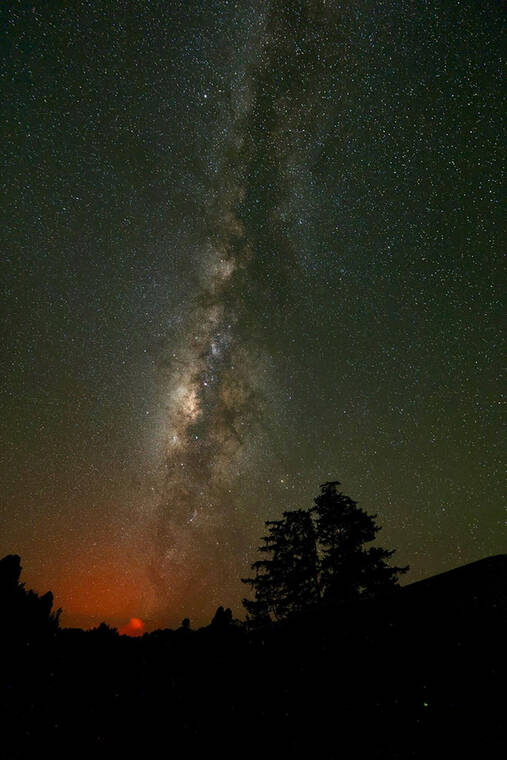
COURTESY USGS
Kilauea Volcano began erupting at about 12:30 a.m. today about a mile south of Kilauea caldera. This view shows the glow of the new eruption under the Milky Way.
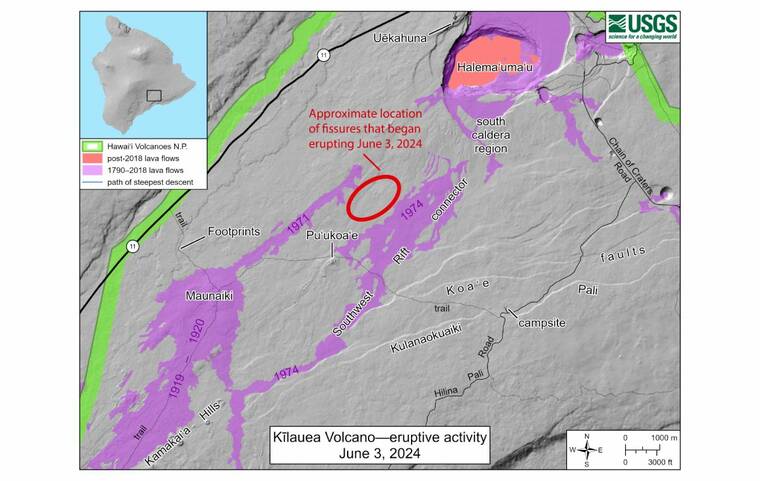
COURTESY U.S. GEOLOGICAL SURVEY
Map showing the location of Kīlauea’s current eruption.






UPDATE: 3:30 p.m.
The Kilauea eruption that began early this morning just southwest of the summit caldera has paused, Hawaiian Volcano Observatory scientists said this afternoon.
“However, activity in this region remains dynamic and could change quickly,” they said in an update. “HVO continues to closely monitor Kilauea and will issue additional notices as needed.”
The eruption began at about 12:30 a.m and lava stopped flowing by about 12:30 p.m., scientists said.
“Earthquake activity decreased greatly in the summit region of Kilauea with the onset of the eruption. All seismicity for the last eight hours is concentrated near Maunaiki at the western extent of the system of cracks that opened during this eruption,” the update said. “Ground deformation has been characterized by slow summit deflation since 2 a.m. HST, suggesting that magma may still be moving from summit storage to the southwest into the eruption area.”
11 a.m.
Don't miss out on what's happening!
Stay in touch with breaking news, as it happens, conveniently in your email inbox. It's FREE!
The Hawaii County Civil Defense Agency has lowered the alert level for Kilauea Volcano from warning to watch and the aviation color code from red to orange.
“The eruption is currently ongoing but is taking place in a remote location within the national park, is low in eruptive volume, and does not pose an immediate threat to human life or critical infrastructure,” the Hawaiian Volcano Observatory said in a bulletin.
The eruption’s remote location also means “the primary hazards at this time are airborne hazards related to gas emissions and tephra being blown downwind of the eruption,” the HVO said. Tephra is the general term for anything thrown into the air during a volcanic eruption.
Although the eruption is occurring in a closed area of the park, park officials announced the following temporary closures for everyone’s safety:
>> Hilina Pali Road from Chain of Craters Road intersection
>> Kulanaokuaiki Campground
>> Pepeiao Cabin
>> Ka’aha Trail and campground
>> Ka’u Desert Trail and pullout on Highway 11
>> Maunaiki Trail
The fissure eruption is in a remote area about 2.5 miles southwest of Kilauea caldera and is not accessible, park officials said.
MONDAY 6:20 A.M.
Hawaiian Volcano Observatory scientists said Kilauea Volcano is now erupting.
“A new eruption began at approximately 12:30 a.m. HST on Monday, June 3, likely about a mile south of Kilauea caldera and north of the Koa’e fault system and Hilina Pali Road, within Hawaii Volcanoes National Park,” the observatory announced at 2:20 a.m.
Hawaii County Civil Defense Agency officials said there are no threats to any communities from lava and that all eruption activity is within the national park.
The volcano alert level has been raised from watch to warning and the aviation color code from orange to red.
“Glow is visible in webcam imagery, indicating that lava is currently erupting from fissures. The most recent eruption in this region was during December 1974, which lasted only about 6 hours. At this time, it is not possible to say how long the eruption will last.”
Civil Defense officials said “some areas may experience elevated gases, take precautions if you are sensitive to volcanic gases.
SUNDAY 11:45 P.M.
Hawaiian Volcano Observatory scientists said late Sunday that the seismic activity near Kilauea’s summit “has decreased slightly but remains elevated.”
They said there have been about 250 earthquakes beneath Kilauea’s summit over eight hours with some seismic activity occurring beneath the upper East Rift Zone. The largest earthquakes included a magnitude-4.1 temblor at 9:12 p.m. and a magnitude-4.0 event at 7:07 p.m.
“At this time, it is not possible to say with certainty if this activity will lead to an eruption – the activity may remain below ground as an intrusion. However, an eruption in Kilauea’s summit region within Hawaii Volcanoes National Park is one potential outcome,” the HVO update said. “The Volcano Alert Level/Aviation Color Code for Kilauea remain at Watch/Orange but conditions could change quickly.”
PREVIOUS COVERAGE
The Hawaiian Volcano Observatory has raised the Kilauea volcano alert level for ground-based hazards from advisory to watch and the aviation color code from yellow to orange.
Scientists said Sunday that Kilauea is not erupting, but that increased earthquake activity and ground deformation at Kilauea’s summit began at approximately noon, indicating the likely movement of magma underground. Rates of seismicity and deformation increased further after 5 p.m. Scientists said at this time it is not possible to say with certainty if this activity will lead to an eruption, and that the activity may remain below ground.
However, an eruption in Kilauea’s summit region within Hawaii Volcanoes National Park is one potential outcome, HVO said. HVO said it continues to closely monitor Kilauea for signs of increasing activity.
Rates of seismicity and ground deformation beneath the East Rift Zone and Southwest Rift Zone remain low, HVO said. Current activity is restricted to the summit region.



